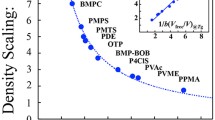Abstract
A new model for molecular rearrangements in liquids is proposed. The liquids are regarded as dense ensembles of vibrating molecules satisfying the excluded volume condition. A continuity condition is applied on the molecular scale of such systems and is regarded as controlling rearrangements leading to translations of molecules beyond the range of their vibration amplitude. It results in cooperative rearrangements which are considered as taking place in systems with fluctuating density. Rates of rearrangements are considered as being controlled by thermal activation with activation energy barriers dependent on local density. Various dependencies of the activation energy barriers on local density are examined. It is shown, that the model is able to reproduce the extremal cases of temperature dependencies of relaxation times represented on one edge by the Arrhenius relation and on the other edge by the Vogel-Fulcher-Tamman relation. The model can, however, provide a broad spectrum of other dependencies filling the gap between these extremes. All cases are based on the uniform microscopic picture of cooperative molecular rearrangements resulting from system continuity. The model is implemented as a simulation algorithm (Dynamic Lattice Liquid - DLL algorithm) which is used to simulate dynamic properties of liquids and polymer melts. Simulation results obtained for polymers are compared with experimental results obtained by means of the dynamic mechanical measurements on polyisobutylene samples with various molecular weights.
Similar content being viewed by others
References
S. Brower, Relaxation in Viscous Liquids and Glasses, The Am. Ceramic Soc., Columbus, OH, 1985
W. Götze in Liquids, Freezing and Glass Transition, eds. J. P. Hansen, D. Levesque and J. Zinn-Justin, North-Holland, Amsterdam 1991
E. Donth, Relaxation and Thermodynamics in Polymers, Akademie Verlag, Berlin 1992
J. A. Barker and D. Henderson, Rev. Mod. Phys.48, 587(1976)
B.J. Alder and T.E. Wainwright, J. Chem. Phys.31, 459(1969)
A. Widom, Phys. Rev. A 3, 1394(1971)
R. Kubo, Rept. Progr. Phys. 29, 255(1966)
R. E. London, J. Chem. Phys. 66, 471(1977)
W. Götze and L. Sjögren, Rep. Prog. Phys. 55, 241(1992)
M.H. Cohen and G.S. Grest, Phys. Rev. B, 20, 1077(1979)
G. Adam and J.H. Gibbs, J. Chem. Phys. 43, 139(1965)
P. J. Flory, ‘Principles of Polymer Chemistry’, Cornell Univ. Press, Ithaca 1953
S.F. Edwards and T. Vilgis, in Physics of Disordered Materials, Eds.: D. Adler, H. Frizsche and S.R. Ovshinsky, Plenum, London 1985
T. Pakula, Macromolecules 20, 679(1987)
S. Glasstone, K.J. Laider and H. Eyring, The Theory of Rate Processes, NcGraw-Hill, New York, 1941
H. Vogel, Phys. Z. 22, 645 (1921); G.S. Fulcher, J. Am. Ceram. Soc. 8, 339 (1953)
M.L. Wiliams, R.F. Landel and J.D. Ferry, J. Am. Ceram. Soc. 8. 339(1953)
H. Bässler, Phys. Rev. Lett. 58, 767(1987)
J. Souletie and D. Bertrand, J. Phys. France 51. 1627(1991)
C.A. Angel, C. Alba, A. Arzimanoglou, R. Böhmer, J. Fau, Q. Lu, E. Sanchez, H. Senapati and M. Tatsumisaga, in Slow Dynamics in Condensed Matter, ed. K. Kawasaki, M. Tokuyama and T. Kawakatsu, AIP New York 1992
P.B. Macedo and T.A. Litovitz, J. Chem. Phys. 42, 245(1965)
J. Koppelmann, in Proceedings of the international Congress on Rheology, 4th, ed.E.H. Lee and A.L. Copley, Willey, New York 1965.
B.D. Hughes, Random Walks and Random Environments, Clarendon Press, Oxford, 1995
T.S. Chow, Macromol. Theory Simul. 4, 397(1995)
F. Stickel, E.W. Fischer and R. Richert, J. Chem. Phys. 102, 6251(1995)
J. Teichmann, PhD Thesis, Universität Mainz, 1996
T. Pakula and J. Teichmann - in preparation
T.G. Fox and P.J. Flory, J. Appl. Phys. 21, 581(1980)
Acknowledgement
The authors gratefully acknowledge E. W. Fischer, F. J. Stickel and J. Reiter for numerous stimulating discussions.
Author information
Authors and Affiliations
Rights and permissions
About this article
Cite this article
Pakula, T., Teichmann, J. A Model for Relaxation in Supercooled Liquids and Polymer Melts. MRS Online Proceedings Library 455, 211–222 (1996). https://doi.org/10.1557/PROC-455-211
Published:
Issue Date:
DOI: https://doi.org/10.1557/PROC-455-211




